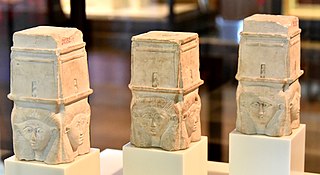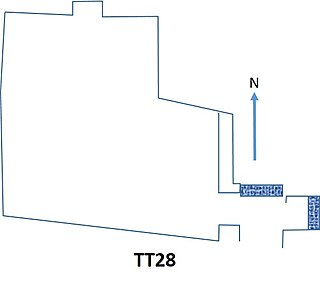Related Research Articles

A mummy is a dead human or an animal whose soft tissues and organs have been preserved by either intentional or accidental exposure to chemicals, extreme cold, very low humidity, or lack of air, so that the recovered body does not decay further if kept in cool and dry conditions. Some authorities restrict the use of the term to bodies deliberately embalmed with chemicals, but the use of the word to cover accidentally desiccated bodies goes back to at least the early 17th century.

Saqqara, also spelled Sakkara or Saccara in English, is an Egyptian village in the markaz (county) of Badrashin in the Giza Governorate, that contains ancient burial grounds of Egyptian royalty, serving as the necropolis for the ancient Egyptian capital, Memphis. Saqqara contains numerous pyramids, including the Pyramid of Djoser, sometimes referred to as the Step Pyramid, and a number of mastaba tombs. Located some 30 km (19 mi) south of modern-day Cairo, Saqqara covers an area of around 7 by 1.5 km.

Mummy portraits or Fayum mummy portraits are a type of naturalistic painted portrait on wooden boards attached to upper class mummies from Roman Egypt. They belong to the tradition of panel painting, one of the most highly regarded forms of art in the Classical world. The Fayum portraits are the only large body of art from that tradition to have survived. They were formerly, and incorrectly, called Coptic portraits.

Blond or blonde, also referred to as fair hair, is a human hair color characterized by low levels of eumelanin, the dark pigment. The resultant visible hue depends on various factors, but always has some yellowish color. The color can be from the very pale blond to reddish "strawberry" blond or golden-brownish ("sandy") blond colors. Occasionally, the state of being blond, and specifically the occurrence of blond traits in a predominantly dark or colored population are referred to as blondism.

The Petrie Museum of Egyptian Archaeology in London is part of University College London Museums and Collections. The museum contains over 80,000 objects, making it one of the world's largest collections of Egyptian and Sudanese material. It is designated under the Arts Council England Designation Scheme as being of "national and international importance".

Tomb KV60 is an ancient Egyptian tomb in the Valley of the Kings, Egypt. It was discovered by Howard Carter in 1903, and re-excavated by Donald P. Ryan in 1989. It is one of the more perplexing tombs of the Theban Necropolis, due to the uncertainty over the identity of one female mummy found there (KV60A). She is identified by some, such as Egyptologist Elizabeth Thomas, to be that of the Eighteenth Dynasty pharaoh Hatshepsut; this identification is advocated for by Zahi Hawass.
In ancient Egypt, cats were represented in social and religious scenes dating as early as 1980 BC. Several ancient Egyptian deities were depicted and sculptured with cat-like heads such as Mafdet, Bastet and Sekhmet, representing justice, fertility, and power, respectively. The deity Mut was also depicted as a cat and in the company of a cat.

Tuna el-Gebel was the necropolis of Khmun. It is the largest known Greco-Roman necropolis in Egypt, dating from the New Kingdom to the Roman Period, and seeing heavy use in the Ptolemaic Period. Tuna el-Gebel is located in Al Minya Governorate in Middle Egypt.

Tomb KV50 is located in the Valley of the Kings, in Egypt. It was discovered in 1906 by Edward R. Ayrton excavating on behalf of Theodore M. Davis. Together with KV51 and KV52, it forms a group known as the "Animal Tombs". It contained the burial of a dog mummy and a mummified monkey and is probably associated with the nearby tomb of Amenhotep II (KV35).

Faiyum is a city in Middle Egypt. Located 100 kilometres southwest of Cairo, in the Faiyum Oasis, it is the capital of the modern Faiyum Governorate. It is one of Egypt's oldest cities due to its strategic location.
Qar was a doctor during the Sixth Dynasty of Egypt, which lasted from about 2350 to 2180 BC. He was the royal physician.

The Gebelein predynastic mummies are six naturally mummified bodies, dating to approximately 3400 BC from the Late Predynastic period of Ancient Egypt. They were the first complete predynastic bodies to be discovered. The well-preserved bodies were excavated at the end of the nineteenth century by Wallis Budge, the British Museum Keeper for Egyptology, from shallow sand graves near Gebelein in the Egyptian desert.
Charles Wilfred Griggs is a professor of ancient scripture at Brigham Young University.

The Xiaohe Cemetery, also known as Ördek's Necropolis, is a Bronze Age site located in the west of Lop Nur, in Xinjiang, Western China. It contains about 330 tombs, about 160 of which were looted by grave robbers before archaeological research could be carried out.

The Theban Tomb TT28 is located in El-Assasif. It forms part of the Theban Necropolis, situated on the west bank of the Nile opposite Luxor. The tomb is the burial place of the ancient Egyptian official, Hori.

Usermontu is an ancient Egyptian mummy exhibited at the Rosicrucian Egyptian Museum in San Jose, California.

Mummies: A Voyage Through Eternity is a 1991 illustrated monograph on the Egyptian mummies, ancient Egyptian funerary practices and the history of the discoveries of Egyptian mummies. Co-written by the French historian Françoise Dunand and the medical doctor Roger Lichtenberg, and published in pocket format by Éditions Gallimard as the 118th volume in the "Découvertes Gallimard" collection.
The monastery of the Archangel Gabriel at Naqlun – a Coptic monastery of the Archangel Gabriel located in northern Egypt, in the Faiyum Oasis, 16 km south-east of the city of Faiyum in the Libyan Desert. Since 1986, it is investigated by a team of researchers from the Polish Centre of Mediterranean Archaeology University of Warsaw, headed by Prof. Włodzimierz Godlewski. In 1997, the Church of St. Gabriel was restored.
The archaeology of ancient Egypt is the study of the archaeology of Egypt, stretching from prehistory through three millennia of documented history. Egyptian archaeology is one of the branches of Egyptology.

Gurob, also known as Ghurab, Medinet Gurob or Kom Medinet Gurob is an archaeological site in Egypt, close to the Fayum. In the New Kingdom it was the place of a palace and was called Merwer.
References
- 1 2 Pruitt, Sarah (19 December 2014). "Egyptian Cemetery May Contain a Million Mummies". History . Retrieved 17 April 2015.
- 1 2 3 BYU Press release
- ↑ C. Wilfred Griggs, "Excavating a Christian Cemetery Near Selia, in the Fayum Region of Egypt", in Excavations at Seila, Egypt, ed. C. Wilfred Griggs, (Provo, Utah: Religious Studies Center, Brigham Young University, 1988), 74–84.
- ↑ Osborne, Hannah (17 December 2014). "One million 'mummies' discovered in ancient Egyptian cemetery". International Business Times. Retrieved 17 December 2014.
- ↑ Jarus, Owen (17 December 2014). "Million-Mummy Cemetery Unearthed in Egypt". Live Science. Retrieved 17 December 2014.
- ↑ Newsweek
- ↑ "Egyptian cemetery may hold over one million mummies". www.haaretz.com. Haaretz. 20 December 2014. Retrieved 22 December 2014.
- ↑ "Fayoum antiquities official denies 'million mummies' reports". Ahram Online. Retrieved 21 December 2014.
- ↑ "Egypt antiquity ministry slams US mission after 'million mummy' controversy". Ahram Online. Retrieved 21 December 2014.